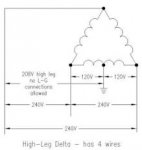Cfris
New member
- Location
- Las Vegas, Nevada, USA
Hi, I'm an EE student and was wondering if I can get some clarity on a couple topics. I have been researching the Grounded Delta configuration, also known as the "high leg" configuration. And while I understand how the voltages are calculated I cannot find anything on how to determine the phase angles from phase to phase and each phase to neutral? does this grounding change the angles for each phase?



